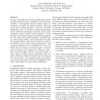Free Online Productivity Tools
i2Speak
i2Symbol
i2OCR
iTex2Img
iWeb2Print
iWeb2Shot
i2Type
iPdf2Split
iPdf2Merge
i2Bopomofo
i2Arabic
i2Style
i2Image
i2PDF
iLatex2Rtf
Sci2ools
SDM
2004
SIAM
2004
SIAM
Class-Specific Ensembles for Active Learning
In many real-world tasks of image classification, limited amounts of labeled data are available to train automatic classifiers. Consequently, extensive human expert involvement is required for instance labeling. Detecting Egeria densa in digital imagery is one such real-world classification task. It presents an additional challenge due to subtle spectral changes in Egeria, which makes it difficult to find a single accurate classifier. A novel solution is proposed to employ an ensemble of classifiers for each class (class-specific ensembles), combined with an active learning scheme. The class-specific ensembles are implicitly diverse. Diversity is required to increase the overall accuracy when combining predictions. The combined predictions of the ensembles can be used to reduce the uncertainty in detecting Egeria. Iterative active learning is then suggested to adapt the ensembles to the new images, unseen to the active learner. A novel solution to build compact ensembles is also prese...
| Added | 31 Oct 2010 |
| Updated | 31 Oct 2010 |
| Type | Conference |
| Year | 2004 |
| Where | SDM |
| Authors | Amit Mandvikar, Huan Liu |
Comments (0)

